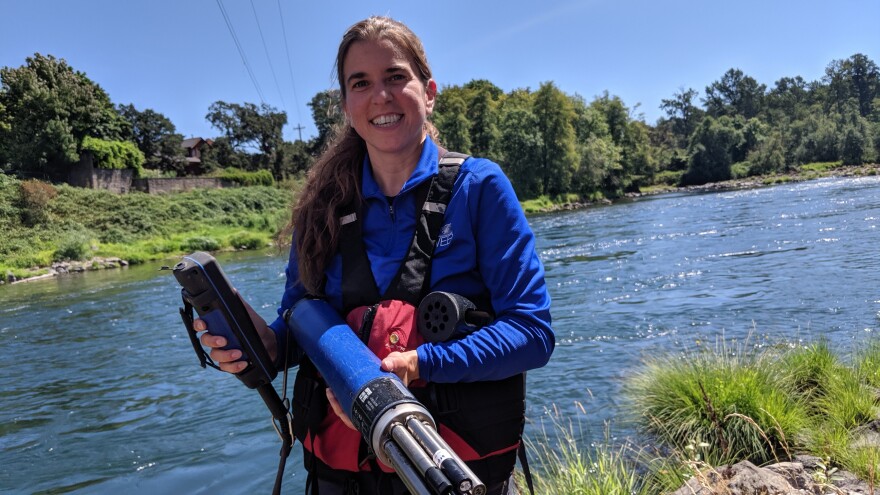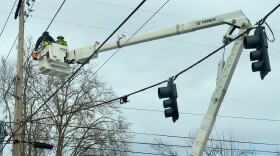Eugene residents are fortunate to get their water from the clean, cool McKenzie River. But the city could lose that access in the event of a major disaster. The threat of climate change has also created challenges.
As part of our UO Wayne Morse Center For Law and Politics Series on Oregon’s Natural Resources and Resilience we look at how people are trying to make the McKenzie River more resilient.
The McKenzie River snakes its way west from its source in the Cascade Mountains. The volcanic rock in the Cascades captures and filters rain and snowmelt underground for years before the water bubbles up out of a network of springs at Clear Lake.

Here at Hayden Bridge in East Springfield Eugene Water and Electric Board takes in water from the river. Karl Morgenstern is EWEB’s Water Quality Supervisor.
Morgenstern: “And we draw basically right out of the river. The intake, we rebuilt a few years ago so now we have pipe that goes along the bottom that’s perforated, with fish screens on it, and we just suck it off the bottom now.”
Morgenstern says, the McKenzie River’s water is known for its purity, but there are sensors here and at other locations along the river to detect any impurities. One of those is cyanotoxin. It’s only in recent years that EWEB has found algal blooms, which can contain the toxins, in its reservoirs upstream. A technician is taking water samples with a jar on the end of a stick.

“We usually try to get at least 6 inches below the surface.” Says technician Lisa Erckert.
Morgenstern says they’ll take the sample back to the lab. “So, we can actually see cyanobacteria and confirm that yeah it’s there or not.”
Cyanobacteria was to blame last year when Salem’s tap water was under an advisory for several weeks. Morgenstern says he increased their sampling after the discovery of algal blooms.
They’re thought to grow in warmer water, likely caused by climate change. That’s what Morgenstern says is the biggest threat to the McKenzie.
“The things that we see impacting us from climate change is lower flows, more drought-like conditions, longer summers.” Morgenstern says, “And then more flooding in the winter where you have more rain coming down over a short period of time, less snowpack. And then the other is wildfires.”
Morgenstern says he’s working with the Forest Service and Oregon State University to study how last summer’s Terwilliger fire affected the McKenzie. Most of the McKenzie Watershed is forest, managed by the U.S. Forest Service or private timber. About 5 percent is agricultural land and about 1 percent is privately owned land. EWEB also works with property owners along the river to restore riparian areas and flood plains.
“Having healthy flood plain, not only helps with drought, cause there’s more sponge there soaking up water, but during floods, it helps knock down flood velocities, reduce damages and so it’s kind of a win-win.” Morgenstern says.

Carol and John Sullivan have a Hazelnut orchard near Vida. Their 70 acre property is along the McKenzie.
“The tree was just covered in ivy. Every single tree really. Sullivan-dead ivy
Carol Sullivan shows me where crews have removed invasive plants by the river.
“ Blackberries galore.” Sullivan says. “Just blackberries. You couldn’t walk into this. I mean they were just blackberries. And Scotch broom.”
Sullivan joined what’s called the Pure Water Partners program about 4 years ago. The coalition includes EWEB, McKenzie Watershed Council, and others with the goal to maintain clean drinking water. It pays participating property owners and businesses.
“And then came in and planted the indigenous trees, the maple, the Oregon grape and then a list of maybe 7 or 8 more.”
Sullivan says her grandparents bought this property in the 1920s. She’d like her grandchildren to live here.
“We don’t feel like we own the land or the river, because, we’re not that great!” Sullivan says, “But we certainly want to be good stewards and it’s wonderful.”

The McKenzie Watershed Council’s Jared Weybright says securing large pieces of land from development is key to the river’s resiliency.
“Best bang for the buck is acquiring flood plain pieces and holding them in perpetuity and managing them for their conservation values.”
This is being done through collaboration between public agencies and non-profits like McKenzie River Trust and the Nature Conservancy.
EWEB is seeking secondary water sources in case an earthquake causes significant structural damage and cuts off water to Eugene residents. EWEB’s Joe Harwood says that’s why they’ve installed wells at Prairie Mountain School and Howard Elementary.
“The idea is build 3 or 4 more of those well sites that are geographically spread out so that if we do have an issue like the Cascadia Subduction Zone quake, folks can still get water.”
Harwood says the wells are part of EWEB’s resiliency initiative. They’ve formed a partnership with Springfield Utility Board to explore ways to collaborate on secondary water sources on the Willamette.
For Karl Morgenstern, when it comes to the McKenzie’s long-term resiliency, he’s most afraid of the unknown. With a changing climate, he says, there could be extreme events, like floods and wildfires on a scale we’ve never seen.
“We’re trying to create resiliency in our system so we can bounce back.” Morgenstern says, “But not knowing what these extreme events might be in 10, 20 years is hard to fathom.”

Still, Morgenstern is hopeful that the work he and others are doing to secure the river’s health and long term resiliency will make a difference.
“We have HJ Andrews, which is a great research station in our watershed. We work closely with OSU, U of O, and now University of Toronto. And so I think we’re engaging the right people to try to think about what might be and how we might be impacted, that can help us understand what to expect and then plan for it.”
EWEB is a KLCC Underwriter and had no editorial input in this story.
Funding for our Resilience and Oregon’s Natural Resources Series comes from the University of Oregon Wayne Morse Center for Law and Politics.
Copyright 2019 KLCC.











